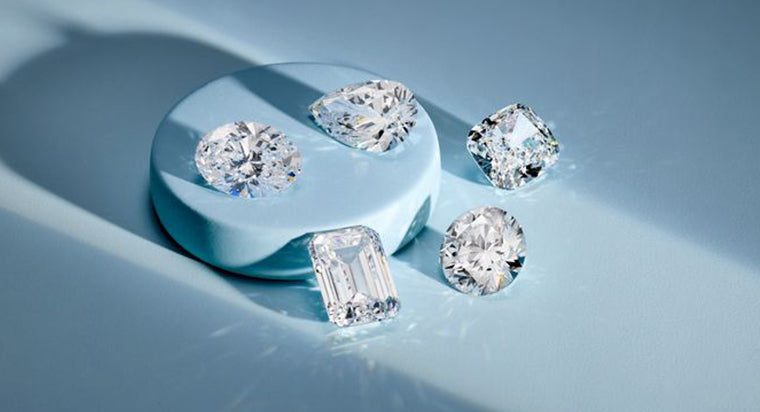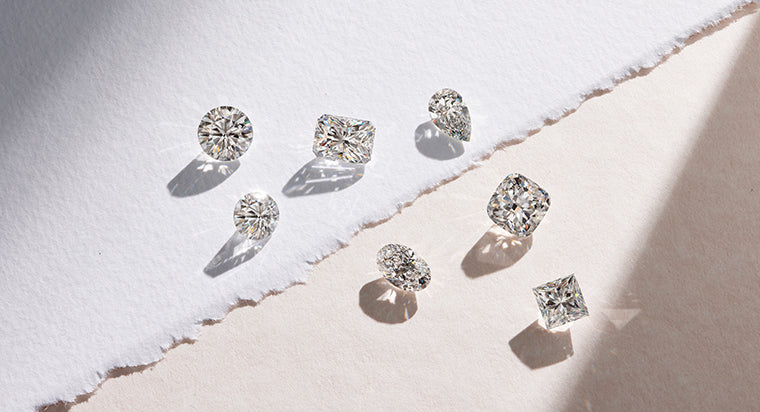What are Diamond Sizes?

Diamond size is often the first aspect considered when shopping for an engagement ring--and diamond carat size is arguably the most infamous of a diamond's 4Cs.
Although commonly confused, diamond carat size and diamond size are not the same. Diamond carat size is a unit of weight specifically used for gemstones, with a metric “carat” quantified as 200 milligrams. Each carat is further subdivided into 100 "points," allowing for extremely precise measurements. Diamonds under one carat are often described solely by points. For example, a "twenty-five pointer" is a 0.25ct diamond.
TABLE OF CONTENTS
Measuring Diamond Size
In contrast, diamond size is quite literally the size of a diamond--its diameter or length-to-width ratio as measured in millimeters. Due to differing measurements and cut proportions, not all diamonds of equal carat weight will appear the same in size. For example, varying diamond depths can cause diamonds of the same face-up size to have drastically different carat weights.
In addition, a diamond that is twice as heavy as a different stone will not necessarily appear twice as large in size. For example, when cut to ideal proportions, a 1 carat round diamond is approximately 6.5mm while a 0.5 carat diamond is approximately 5.0mm. Even though the carat weight is double, the 1 carat stone is not twice as large as the 0.5 carat diamond.
Fancy Shaped Diamonds
When it comes to fancy shaped diamonds, the diamond size, as described by the length-to-width ratio, becomes largely a matter of style. For example, for heart shaped diamonds, a 0.9mm x 1mm stone is a significantly "fuller" and rounder heart than a 1mm x 1.1mm diamond. Fancy shaped diamonds are more complex when translating diamond carat size to diamond size because of the various combinations of proportions. Two fancy shape diamonds of similar diamond carat size can easily vary dramatically in diamond size. In addition, diamond carat size can be visualized differently due to the type of gemstone, as different gemstones have different densities, affecting the diamond carat sizes.
Many shoppers commonly have trouble visualizing diamond size (mm) when given information regarding diamond carat size. A diamond size chart is a great way to effectively make diamond size comparisons, quickly translating carat to mm. As diamond size comparisons differ by the diamond's shape, be sure to look at the diamond size chart that corresponds to the correct diamond shape.
Diamond Pricing
Diamond prices rise exponentially with carat weight because larger diamonds are much less common, and thus more valuable. The general rule of thumb indicates that a diamond of double the weight costs around four times the price. In addition, remember that carat is just one of the 4Cs. Two diamonds of the same diamond carat size can easily have different prices due to differing cut, color, and clarity.
However, bigger--whether it be carat or size--is not always better. Be wary of diamonds that are priced unexpectedly low. Each carat has an ideal size proportion that optimizes its visual beauty--and falling out of that range can result in a less than magnificent diamond.
Carat Size Cutoff Weights
The typical diamond carat size cutoff weights are 0.50 ct., 0.75 ct., 0.90 ct., 1.00 ct., 1.50 ct., and 2.00 ct. If you're on a budget, consider buying diamonds below standard carat weight cutoffs. While the visual difference between a 1.50ct diamond and a 1.40ct diamond is negligible, the monetary savings isn't.
While people often fixate on carat or size when selecting a diamond, cut is actually one of the most significant factors in choosing a visually stunning diamond. Cut influences the diamond's sparkle, and diamonds with less depth and more spread often look visually larger than its carat weight.
Tips for Diamond Buying
When selecting the perfect diamond, avoid fixating on any one of the 4Cs. A beautiful diamond requires balance. Finding the perfect combination of cut, carat, color, and clarity is what truly makes for a stunning diamond.
FAQs
Does diamond size and diamond carat mean the same thing?
Diamond size and diamond carat do not mean the same thing, they are related but they are different measurements. Diamond size refers to the physical dimensions of a diamond, such as its length, width and depth. It's the way the diamond looks to the eye. Diamond carat, on the other hand, refers to the weight of the diamond. One carat is equal to 0.2 grams or 200 milligrams. So, a 1-carat diamond weighs 200 milligrams, 2-carat diamond weighs 400 milligrams and so on. A diamond of the same carat weight can have different size depending on its cut, the depth and table percentages, a diamond with a deeper depth will appear smaller than one with shallower depth. Therefore, it is important to consider both the carat weight and the physical dimensions of a diamond when evaluating its size.
Does the carat weight affect the price of the diamond?
The carat weight is one of the factors that can affect the price of a diamond. Generally, as the carat weight of a diamond increases, so does its price. This is because larger diamonds are more rare and therefore more valuable. However, it's worth noting that carat weight is not the only factor that affects the price of a diamond. Other factors such as cut, color, and clarity also play a role in determining the value of a diamond. A diamond with a high carat weight but poor cut, color, or clarity may not be as valuable as a diamond with a lower carat weight but better overall quality. Additionally, the shape of the diamond also plays a role, for example, fancy shape diamonds are typically cheaper than round ones in the same carat weight. The location of the diamond mine and the demand of the diamond in the market also affect the price. It's important to evaluate all of these factors together when determining the price of a diamond, and consider the overall value and beauty of the diamond, rather than just its carat weight.
What diamond carat weight is best for an engagement ring?
The best carat weight for an engagement ring is a matter of personal preference and budget. Some people prefer larger diamonds and are willing to pay more for a higher carat weight, while others prefer smaller diamonds or are working with a limited budget. A 1-carat diamond is a popular choice for an engagement ring, as it is large enough to make a statement but not so large that it becomes too expensive. A diamond of 0.5-carat is also a good choice for an engagement ring, it is smaller in size but it can be less expensive, and also can have better quality than a diamond of a higher carat weight. Ultimately, the best carat weight for an engagement ring is the one that fits your personal style, budget, and preferences. It's important to consider not just the carat weight but also the diamond's cut, color, and clarity when making your selection.








